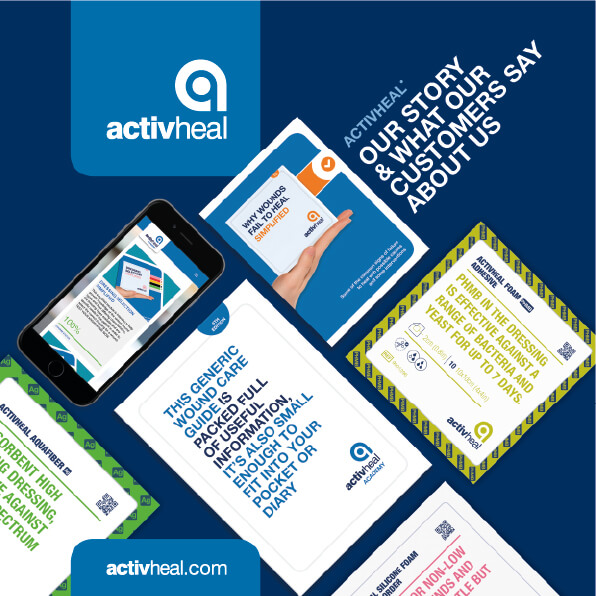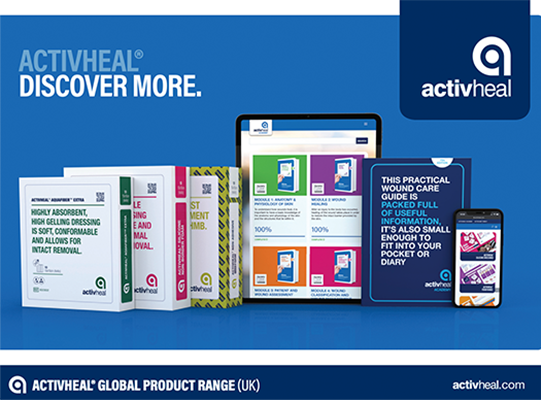What is ActivHeal®?
ActivHeal® is a range of wound care dressings indicated for use on a variety of chronic and acute wounds. The dressings have been developed to keep the wound moist which creates an ideal wound healing wound environment, protecting the wound and protecting the peri-wound area.
What is moist wound healing?
Moist wound healing was a term coined by Winter (1962) that was discovered when superficial wounds in pigs, covered with polythene, healed nearly twice as quickly as those left to dry and scab. The polythene retained moisture in contact with the wound supporting, epithelial cell migration. The theory of moist wound healing led to the development of many modern day occlusive dressings that provide a moist healing environment.
Where can I buy ActivHeal®?
ActivHeal® is available through NHS Supply Chain, and is also available in pharmacies through the Drug Tariff.
What types of wounds can ActivHeal® be used on?
ActivHeal® is a wound care range designed and developed to be used on chronic and acute wounds. The variety of different indications of the dressings makes ActivHeal the ideal dressing range to be used on a wound through the different stages of wound healing.
What is ActivHeal® Alginate made of?
ActivHeal® Alginate is made from seaweed; from a combination of the stem and the leaf of the seaweed, as this gives different performance of the dressings, e.g. high wet strength, high absorbency etc. ActivHeal Alginate is in fact high in guluronic acid, ensuring the product has a high wet strength.
Is alginate biodegradable?
There is evident to support that alginates break down into simple monosaccharide type residue and are totally absorbed by the body.
Is your alginate a licensed haemostat?
Our alginate dressings have regulatory approval through a CE Mark, which has approved the use of our product to claim that the dressing can be used to control minor bleeding.
Can ActivHeal Aquafiber® be used under compression?
Yes, ActivHeal Aquafiber® can be used under compression bandaging. One of ActivHeal Aquafiber’s® key attributes is the vertical wicking properties of the dressing. This enables clinicians to layer the dressing onto the wound without the risk of the peri-wound maceration.
Can ActivHeal Aquafiber® be wet and then used on necrotic wounds?
No, ActivHeal Aquafiber® should not be wet and used on necrotic wounds, as the dressing does not donate fluid – a hydrogel should be used for this purpose. ActivHeal Aquafiber® is primarily for the absorption of exudate and providing a moist wound environment which would facilitate autolytic debridement of necrotic tissue if present in an exuding wound.
What is the difference between ActivHeal® Alginate and ActivHeal Aquafiber®?
Our Alginate product is high in Gulronic acid which is taken from the stems of the seaweed. This provides a high wet strength. ActivHeal Aquafiber® is high in Maluronic acids, which is taken from the leaf of the seaweed. This provides high flexibility and clear gelling properties. Both ActivHeal Aquafiber® and Alginate provide similar properties during wound healing; however, if maceration is a concern, then the vertical wicking properties of the ActivHeal Aquafiber® will reduce the risk of maceration and provide clear gelling properties.
What are the clinical features and benefit of using a foam dressing?
- Waterproof – Allows the patient to shower – Protects the wound from urinary incontinence
- Bacterial Barrier – Prevents wounds from becoming infected – Prevents bacteria from cross-contaminating other wounds
- Soft and Conformable – Comfortable for the patient – Conforms to the contours of the body – Helps the dressing to stay in place
- Low Friction Backing – Reduces rucking of dressing – Increases wear time, Effective absorption properties – Ensures that the wound does not become macerated, Increases the wear time of the dressing
- Maintains a moist wound healing environment – helps to facilitate wound healing, prevents desiccation of the wound bed, allows autolytic debridement if required
- Reduces the risk of maceration – Ensures that the peri-wound does not breakdown, improves healing outcome
- Non Adhesive – Makes it ideal for friable skin and for use under compression bandaging.
When should I use ActivHeal® Foam Non Adhesive?
ActivHeal® Foam non-adhesive is ideal when reducing trauma is a key part of the wound dressing regime. It has soft and flexible properties mean patients can wear it underneath clothing with comfort and confidence. It can be cut to the size required and secured with either a bandage or an appropriate tape. ActivHeal® Foam non-adhesive is ideal for use under compression. The ActivHeal® Foam non-adhesive range offers a variety of shapes and sizes including; the ActivHeal® Foam Heel dressing specifically designed to apply easily to the heel and other bony anatomical areas. The ActivHeal® Foam Tracheostomy dressing features a versatile fenestration, allowing it to fit neatly around a tracheostomy tube, intubation tube, cannula insertion, external bone fixators and appropriately sized wound drainage tubes.
What is the difference between MVTR and Absorbency properties of a dressing?
The MVTR stands for Moisture Vapour Transfer Rate – this is where the exudate from a wound is passed through the dressing in a form of vapour. This is not a useful trait if the dressing is occluded. The absorbency of the dressing is the measurement of exudate that is absorbed into the foam and is removed from the wound bed preventing wound maceration. The total fluid handling is the combination of the MVTR and absorbency of the dressing.
What is the difference between ActivHeal® Hydrocolloid Film Backed and ActivHeal® Hydrocolloid Foam Backed?
Our film-backed dressing provides a low-profile dressing, whereas our foam-backed dressing provides an increased cushioning. The foam-backed hydrocolloid is a useful property when comfort is important for the patient experience. They both have similar total fluid handling capabilities.
Does your ActivHeal® Hydrogel allow for use with larvae therapy?
No, you cannot use Hydrogel in conjunction with maggot therapy, as it contains propylene glycol which would in effect kill the maggots. However, thoroughly cleansing the wound prior to maggot therapy, ensuring that the gel is completely removed, will allow maggot therapy to be carried out successfully.
What does the hydrogel contain?
The majority of gels mainly consist of water with ActivHeal, containing 85% water, propylene, glycol, and other polymers.
What secondary dressing would you advise for a hydrogel?
It is recommended that either a foam or film is used as a secondary dressing to hold the gel in place.
Which side should the ActivHeal® Foam Tracheostomy be placed?
ActivHeal® Foam Tracheostomy should be placed around tracheostomy and other fixation devices so the pink side of the dressing is facing upwards. The pink film backing is the waterproof bacterial barrier and will therefore ensure the protection of the wound site. If you would like more information regarding the application of the ActivHeal® Foam Tracheostomy dressing you can download our application guide by clicking here.


